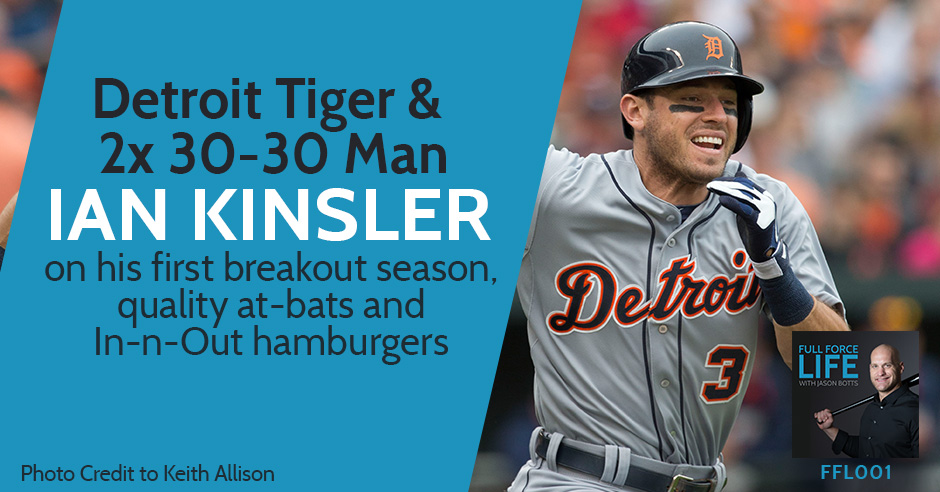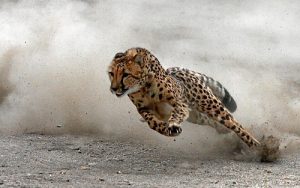
Hey, everybody. This is Jason Botts. Welcome to this first episode of the Full Force Life. Maybe you’re new to me, maybe you’re new to this idea of what I call the Full Force Life, so let me take a little moment here to introduce myself and what this Full Force Life thing is all about.
I always call myself a small town boy with big league dreams. I grew up in the middle of nowhere, California. At the age of fifteen years old, I wanted nothing more than to be a Major League Baseball player. At that time, my skills weren’t very prolific nor was my athleticism to warrant those dreams, but I made it a goal. I knew at that time that it was going to take incredible mental strength and I was out to learn how to focus and to maximize my ability. If I was going to compete against the best of the best across not only the country but the world as well, if I was going to get myself to the professional level and then on to the Major League levels. That moment in my life triggered something inside me, an obsession to learn and to study and to discover peak performance tools and techniques and principles.
Something that I always carried around was a backpack full of books and audio cassettes and notebooks. I would study and I’d read and I’d take these notes down, I’d go out and try to apply it in that night’s game. I did that for years and years. I was able to go to junior college and then earn a professional contract with the Texas Rangers, go and competed for I think four and a half years at the Minor League level and then eventually I got called up to the Major League levels and made my debut playing the Baltimore Orioles. It was a dream come true. I got to live that dream off and on at the Major League level for four seasons, got to play fifteen years professionally all in all, including two years in Japan, years in Mexico in the summer, in the winter, winters in the Dominican, winters in Puerto Rico and had a very long and distinguished career as a world class hitter. That was what I was known for.
Fast forward towards the end of that career, I’m 34, 35 years old and I decided I want to spend more time with my family. I have two amazing sons, Lincoln and Lenox. At the time, I was married. That transitioned, at that time, no longer being a baseball player was something that I had to go through. At first, it was no big deal, it was fine. Be relaxed and not have to worry about the stress and the pressure of trying to get a new contract or going out and competing and just enjoy being with the boys and doing the laundry and washing the dishes and grilling in the backyard and swimming in the pool and doing all the things that retired professional athletes do. At the time, my wife was extremely successful in her business and I was able to just be stay at home dad.
After a while, there’s just this burning fire pot back in my belly that I wanted to do something, I wanted to do something bigger than just my baseball career, something that was meaningful, that contributed to the lives of others directly. Baseball, it was great, I loved every minute of it, but you never really had that sense of contribution, at least in my own opinion. Maybe you were an entertainer and someone got to escape their world for a little while by drinking a beer and eating a hotdog and cheering you on or cheering against you for that matter. But there was not a lot of one on one contribution and a deep meaning. That was something that I was craving once my retirement came to me.

After feeling lost not being a baseball player, I didn’t know what I wanted, I didn’t know how I wanted to help people. It started really bothering me. I crept into depression and I started feeling completely out of sync in my relationship and overwhelmed as a father and stressed. It was a challenge every day to get them together, because they’re small at the time, three and five years old I think. It was a challenge to get them to preschool every day. I was feeling more and more helpless, hopeless and worthless.
I remember this one moment of sitting in my room and going, “I know that there’s so much more that I could be doing with my life.” I just couldn’t figure it out. I felt so weak mentally, I felt so out of sync, so lost with who I am. It was just so shocking to me because here I was on this one mission, so driven, so focused, such incredible mental strength.
My entire life, when it came to baseball, I studied this stuff, I knew this stuff. How was it that in my baseball career I can dig into a batter’s box and do what’s considered in all of sports, the most challenging thing in all of sports is hit a baseball. How could I do it at a world class level but yet I’m overwhelmed with the kids, or I can’t communicate with my wife, I can’t even have the courage to tell her how I’m really feeling. How do I take all those great things I did as a baseball player, all these things I studied and I learned, how do I extract it and put it in to everyday life? That was my first question.
At that moment, I dubbed it right away. This is going to be called the Full Force Life. When you get yourself in the zone in all areas of your life, when you start living completely congruent from top to bottom, who you are and what you want, you have the beliefs and the values and everything, the thinking patterns that support it all, exactly where you want to go, that’s going to be the Full Force Life. I wish I could tell you that the heavens parting at that moment and my life changed overnight. It was like taking the magic pill, we all want the magic pill.
But it took me a couple of years to really dive into that question and figure out all the steps and what I did great as an athlete, what I did as a competitor, what I did as a baseball player and take that out and put it into steps that I could use in any area of my life and have helped coach personally other people to do the same in theirs. That’s something I think is important for people to hear, it wasn’t an overnight thing.
There’s going to be a ball player that we’ll talk in a couple episodes, he was in a closet with a gun to his head and almost took his life. He had that moment with the gun, with the hammer cocked back. It wasn’t an overnight transition that he got himself out of depression. It was a year, a two year process where he kept battling and kept trying to stand on his feet. My outcome, my intention for this podcast is to hear stories like that. Our guest today is someone who’s an excellent peak performer. We’re going to have other guests, people who have overcome amazing adversities and cancer. There’s going to be other experts in their fields.
My intention for this show is to be able to model. Modeling was one of the things that I figured out that I did great as a baseball player. As a young ball player, you’re mirroring the actions of other ball players or you’re asking them questions, you’re asking them, what their hidden approach, what are they thinking about, what’s important to them, what are their beliefs about what they can do, what are their beliefs about who they are? You start to emulate them. That’s why young ball players, we improve so quickly at a young age, is because we’re always mirroring. We’re not trying to figure things out ourselves, we’re just trying to mirror everyone around us.
Even Babe Ruth, Babe Ruth was the greatest player of all time. He admitted that during his career, he copied the swing of a man named Shoeless Joe Jackson. Shoeless, you might know, he’s from the movie Field of Dreams. He was part of the 1919, the Black Sox scandal. He lost his career being involved in that. He’s on the Hall of Fame. Not a lot of people know how prolific of a hitter he was. Babe Ruth said that he was the best hitter that he had ever seen and so he copied and he modeled his swing.
That’s what this show’s going to be about. It’s about hearing other people’s stories and modeling what they do, not just their actions but their beliefs and their values and their thinking patterns to get the results that they do. Whether it’s to overcome adversities or to peak perform or to just enjoy an unbelievable happy, fulfilling quality of life because that takes a lot of skill as well to do in today’s age.

I think another important thing to note about the modeling is it doesn’t have to be specific to your needs. You don’t have to be a baseball player, you don’t have to be a young athlete, you don’t have to be a fan of baseball to listen to a Major League hitter and to take something away from how they approach and what they think about. I’ll give you a great example. Just this last week, I was struggling in getting some of the finer details of this podcast all setup. There was a lot of little mundane work. I was trying to do too many things at one time and I got myself out of rhythm, out of sync.
At the very end, today’s guest, Ian Kinsler, he’s going to talk about this amazing analogy. I asked him something along the lines of, how do you get yourself back on track? When you’re out of rhythm, you’re out of sync, how do you get yourself back on track? He gives this beautiful analogy of how a cheetah stalks his prey. It was really profound for me. My brain went there while struggling to get all these little mundane tasks done. I realized that, you know what, if I just start off real slow, like that cheetah and I just sneaks slowly. A cheetah is the fastest animal on the planet, but he doesn’t just see the gazelle and start running at 60 miles an hour after the gazelle. He slowly works his way up and he takes in the surroundings and the situation and makes sure he’s exactly on target. As soon as he’s in full pursuit of that gazelle and that gazelle now darts one way, he’s in time with it, he’s in rhythm and he’s going to totally cut off the gazelle and be right on its tail.
I’ll give you another great example of modeling and changing the context. In a future episode, Michael Young, another great Major League All-Star, a Texas Ranger Hall of Fame member. Michael’s known as being the pro’s pro, extremely professional, extremely focused. I asked him, what is professionalism? What does leadership mean to you? The answer that he gives, the standards, the standards that this man holds himself to when he enters the clubhouse and for everybody in the organization, top to bottom, and how he treats them and how he stays connected with them and how he encourages them is something that if you are a leader in a corporation, in an organization, some type of community, whatever it is, you’re going to be able to take the standards that he holds himself to and the beliefs that he has about it and be able to immediately apply, whether it’s a baseball clubhouse or whether it’s some other type of company, it doesn’t matter. The content doesn’t matter. It’s about what he’s doing, the actions that he’s taking, the thinking patterns behind it. You’re going to see immediate results in your community as well.
That’s the power of modeling. That’s my purpose for this show. Let’s dive into it. Today’s first guest, there was no doubt in my mind who was going to be the first guest. Ian Kinsler, he’s been a friend of mine for a long time. He is an amazing human being. There was no one else I thought would be more fun to interview and to get the ball rolling on this podcast with. Not to mention, he’s an incredible player, four time All-Star, two time member of the 30-30 club, where you hit 30 home runs and steal 30 bases in a single season. Only twelve players have done that, in Major League history, have done that multiple times, twelve players. It’s an incredible feat. Ian is just an incredible human being.
As long as I’ve known him, he’s remained to be the same guy, same playful, fun, loving dude. It doesn’t matter how much money, how many accolades, he’s the same person that I met in 2003. You’ll hear a little bit about that, how we came to be friends in the past. I love this dude to death and I couldn’t be more proud of his career and who he is and the family man that he is and the two amazing children and his amazing wife, Tess. I thank Tess also as well because she let me be the third wheel and sleep a lot of nights on the couch and in the guest rooms over the years too. Special thanks to Tess.
I asked some people on social media, of the guest, who do you want to hear from? The majority was overwhelming to Ian as well. I think that’s a testament to all the things I just mentioned. People and the fans, they recognize that as well too. If you are spending time in the Dallas Fort Worth area and you’re at the dog parks, I can also tell you about this, if you’re at any dog parks in the Dallas Fort Worth area, you’re going to hear a lot of dogs being called by the name Ian and Kinsler, especially after they made those appearances in the World Series. A lot of the dogs started getting called Kinsler.
Anyways, always fun to mess with him. You’ll hear it, great human, great takeaways from this guy. Without any further ado, I want you to hear from Ian himself and begin to takeaway so you can apply it to your life and live in full force. Here he is. I’ll see you guys on the other side.
Listen to the podcast here:
Ian Kinsler – First Breakout Season and Quality At-Bats
Hey, everybody. This is Jason Botts. Welcome to the Full Force Life podcast. Today, we have a special guest. A former teammate and a really great friend of mine. We’re happy to have him on here, Ian Kinsler. Ian, welcome to the show, man.
Thanks for having me. Always good to hear your voice.
Normally, in an interview like this, I dive in with questions, but for the people who are listening, I want to tell a little bit of a story going back to 2004 with Ian and I. I think it applies really well to the idea of this podcast. My outcome for the podcast is to provide value where we can listen to people who are successful at their craft or successful in certain areas of life and have deep fulfillment and a lot of passion and take out their thinking patterns, their beliefs, their values and be able to extract them and apply it to that specific sport if we’re an athlete or to a different area of our life because a lot of things are universal principles and we can do that, apply it to a different area.
2004, I remember I was in Double-A in Frisco. Ian, I think at the time, that was his first full year. He was at the Low A level. On fire, hitting 400. It was about the time of the All-Star break. This was kind of my breakout year as well, high in home runs and batting average and RBIs. I just remember hearing all these great things about Ian. I remember at the time, someone, I think it was Drew Meyer, Drew got hurt at shortstop and they called you up and I remember not knowing you very well at all. But I remember, this is the kind of guy that I want to be around. I think I marched on the bus the first day you got there. I didn’t have a roommate at the time. I don’t think I asked you to be my roommate. I told you that you were going to be my roommate because the success that you were having, I knew what you were thinking and just the mojo that you had going on, that I knew I wanted you close to me for that rest of the year to help me finish my season strong.
It’s a selfish move, maybe I acted like I was trying to help you out, make sure you’ve got a place to stay, but it was a totally selfish in my part. That was our beginning. We were roommates for many years after that. The first question I wanted to ask you was, if you can remember all the way back in those days of 2004 and even 2003, you had this huge breakthrough in your career, do you remember anything to this day of what shifted inside of you? I know there were some mechanical adjustments I remember you making at that time too. What happened inside of you to allow you just to take your performance to a whole other level?

I think it really all started in Instructs in 2003 after my Short Season year. I had an okay Short Season, I wasn’t a high draft pick, I wasn’t on anybody’s big board or whatever. Hit 270, one homer, some doubles, played good defense, nothing crazy. I was actually ecstatic that I got invited to come Instructs. I thought that I was going to be overlooked when it came to Instructs. With the Instructional League after my Short Season year. Honestly, all success really just comes from working your butt off and working your tail off. If you do it the right way and you have the right people around you, usually that leads to success.
The two guys that I worked most closely with, one was Adam Fox. We worked a lot of hours on occasion at Instructs. Also, Ralph Dickenson. This is where the huge breakthrough happened, was Ralph taught me how to hit with my legs. Like you said, mechanics was part of it. I was a free swinger, pool hitter. I hit probably six or seven home runs but they were all foul, pool side and Short Season ball. Basically, just to be able to move everything more to center field and to be able to use my legs to generate more power, he was the guy that basically did that for me. He was the puppeteer.
Once I learned that and I was able to take that into a game, honestly there was a lot of push back to him from other players at Instructs. I bought into it. I felt like it was really helping me. I was so eager to learn, so ready to put myself on the map just because I was a late round draft pick and wanted to make an impression and wanted to learn as much as I could. I was an open book. Once I learned this, from just numerous swings and working with Ralph and was able to apply it to the game and saw success, all of a sudden the confidence level was sky high, went through the roof.
I always felt like I was a really good ball player and I was going to do things well on the field to help my team win, but I never felt like I was that huge impact guy that everybody didn’t want to pitch to or that your teammates want up in a big situation. Once I learned this mechanical adjustment, I felt like that guy. I knew that that guy was in there. I knew that I was capable of being that guy. That’s what clicked it over and I felt like that guy. I started gaining confidence in my abilities and my mechanical moves, the way my body was moving, I felt great.
I put on a bunch of weight. I never really lifted weights appropriately up until that point. When I first came in, I was 175 pounds. That off season of the Instructs, I put on a bunch of weight and got up close to 200 pounds just eating six meals a day. The power started coming, I started driving the ball to ballpark, which I always thought that I could. Driving the ball in the gaps, doing all the things that they’re asking of you. My confidence went through the roof.
Actually, believe it or not, a huge breakthrough moment for me, this is something that I’ll never forget. We were getting ready to break camp, they were going to tell us where we are going to go, whether we are going to go to Low A or High A. I just basically dominated Instructs. I’m thinking, “They’re going to skip me Low A and they’re going to send me to High A.” They ended up putting to Low A. That gave me another chip on my shoulder which I really didn’t need, but it definitely lit a fire under me. I was a little upset about that. I was hurt by that. I was going to use that to show them that they put me in the wrong place.
Last game of the spring training, you know how that goes, everyone swings first pitch, try to get out of there as fast as you can. We got to drive to Clinton, Iowa and we’re facing Edison Volquez, who is now an All-Star in the big leagues and a guy that was a live arm Dominican guy, through sinkers, good slider, had no idea where he was going. He was going to Low A with us and so we had to face him on the last day so that it lined up that he started opening day. Honestly, I was a little nervous about it. This was the first time that I really face somebody that I knew had really good stuff and can probably just blow my doors away. That gave me a little anxiety.
It was the last day of the year. None of us were really locked in, there was really no preparation for that game. Just freewheeling it. I was leading off the game and he threw me first pitch. He was probably 93 to 95 then. Threw me first pitch, outside for a ball. It wasn’t comfortable. He’s got our elbows and arms, elbows and knees and everything going everywhere. He’s firing 95 at you. It wasn’t comfortable at all. I said, “Just get a good pitch. Just trust myself.” I tried to slow everything down. Next pitch, fast ball, wham, slammed it in the left center field gap for a double. That moment I’ll never forget because there was a lot of anxiety, which I never really had playing baseball, but this was really my first official season of pro ball. I was getting ready to go to my first season of pro ball. This wasn’t just 30 games of Short Season or 40 games of Short Season. This was legit. We had to be prepared for this.
To be able to that against Edison, really my confidence built again. I think it really just came down to confidence. Once I felt like, “All of this is working. Everything is going in the direction I wanted it to go. I feel like I’m the best player on this team, I’m going to act like I’m the best player on this team and I’m going to play like I’m the best player on this team,” it all just snowballed from there. That’s where it all started.
I love that at the end right there, talking about, “I’m going to act …” Basically, you just stepped into it, you owned it and it came through.

I went to Short Season and Carlos Sombrero was our head coach. I don’t know if you remember him at all, but he was a no nonsense guy. He didn’t put up with anything. I was a short stop at the time and that was his position. He expected a lot from me. He had me early work every day defensively so I had to double early work because I always wanted to work on the offense side. I think everybody does. I was double duty early work. Defensive, he was pushing me to places I didn’t know I could go as far as getting rid of the ball, back in place, up to middle. All of it just came together at that one stop in Clinton. From there, it was just constant adjustments. That’s what set the base and the foundation for basically the rest of my career.
I had Carlos. He was one of my coaches at my first summer, my Gulf Coast League season. I know he was, as a manager, he was a little bit tougher. I imagine with you, that he saw not only the skills and potential you got as a ballplayer but saw you as someone who was a leader on the team as well. That was the next question I have for you. Whether in the clubhouse or on a baseball field or even overall in life, I know you’re someone who has strong principles and you’ve got a strong foundation for how you want to help other people. What is a leader to you? What does a leader do?
It’s tough to say, but a leader to me is my father really. That’s where I learned from and then obviously learning from people along the way who you idolize, who you look up to and trying to figuring out how they do it and how you can do what you like about them. I played with Mike Young for a lot of years in Texas. You need to lead by example, that’s number one for me. After that, different personalities go different directions. For me, leading by example, it’s a must, it’s a definite in being a leader. You can’t do things, you can’t say things, you can’t act a certain way if you don’t show that this is what you really truly believe, and that’s your actions. For me, it’s all about leading by example.
After that, for me, it’s a constant process. I want to be a leader. I think people at this point in my career look to me to be a leader. I’m very black and white with things. You know how I am. I think things should be done a certain way, especially when it comes to baseball. Things should be a certain way, you should work hard. A lot of that came from playing on teams with you, with the guys that we played with. Everybody worked hard, nobody complained. We did what we had to do to try to win that particular game. That’s how I see the game and that’s how you should prepare for the game, that’s how you should get ready for the game. When someone’s not doing that, sometimes I get a little too vocal. That’s just my personality.
I’m not going to try to change my personality to be a perfect leader of somebody else. If they want to look to me and my example and try to follow that and think that that’s good and see me as a leader that way, I would much rather have it that way than have to sit down with somebody and tell them or show them or teach them something. I would much rather lead through example, because I think that’s the easiest way for people to learn, is visually.
I think in a baseball clubhouse, you bring up some great points. There’s so many leaders. In baseball, there’s never a leader on the team. That’s such a tremendous point that you just made. You walk your own talk and the ones that it resonates with, they follow along. They not necessarily follow just to follow, but they’re developing their own skills, especially in baseball. You’re talking about you’ve got such rookies and guys that you evolve from being a rookie to being a veteran. That’s a process that you’re learning by other people’s examples. I think you just really illustrated that point very well. That was definitely a great answer. I appreciate it.
Thanks, man.
I do a lot of work with young athletes as you know. Baseball, softball and other sports. When it comes to hitting a baseball, you’re talking about a Major League Baseball player especially and someone who’s as successful as you’ve been during your career, I really want the younger kids who might happen to hear this, what constitutes in your mind as a quality at-bat? What do you gauge a successful at-bat and what do you gauge a failure, if you even think that route?
For me, a successful at-bat is just being ready to hit. From pitch one, you’re ready to hit. Baseball is such a crazy game. There’s so many different situations and there’s so many times we should take a pitch when you need to work the pitcher, when you need to move a guy over, when you need to drive a guy in or sack fly or bun the guy over, whatever it may be. All those situations lead to quality at-bat. If you can accomplish what you need to in a certain situation, that’s a quality at-bat.
But there’s also other ways you get quality at-bats. For me, the absolute principles of a quality at-bat is probably seven of them. There’s a hit by pitch, there’s a base hit, there’s a walk, there’s catcher’s interference, there’s moving a guy over or just moving a guy 60 feet, there’s seeing seven pitches or more. I think that’s six. I think there’s one more, but I think we’ll stick with six right now because those are great.
Leading off a game with a homer?
That’s a quality at-bat. That counts.
You’ve gotten pretty good at it over the course of your career.

Just being ready to hit man, from pitch one. You worked with Rudy Jaramillo enough to I think have a little bit of his personality ingrained in your mentality. I know I do. It’s just being ready to hit. You’ve got to be ready from the time that you grab your bat in the hole, what’s your thought process then, to when you’re on deck, what’s your thought process then, to being ready for that first pitch. That’s it. I think that’s what leads to a quality at-bat. You can do all those things, you can grab your bat and be ready in the hole, step on deck, go through your whole process, you’re ready to hit, you feel good, you step on the batter’s box, you’re ready to hit, you get a good pitch, take a swing, fly out, ground out, whatever it may be. When you run back to the dugout lineup, you can even have a lineup, when you run back to the dugout, really determining if it’s a quality at-bat is up to you. I remember what you used to do, something that always sticks with me. You used to check your at-bats red or green or something like that. I can’t remember the colors.
That’s right.
If you had a quality at-bat, regardless of the outcome on the at-bat, because sometimes you can’t control results, most of the time, pretty much all the time I guess. You can’t control the results so if I had a quality at-bat, I remember you used to tell me that, that was a green at-bat. If I didn’t have a quality at-bat, if I got out of myself, I didn’t trust myself, if I swung a bad pitch, if I let the pitcher dictate whatever he dictated, that’s a red. That’s not a quality at-bat. At the end of the day, you could be 0 for 4 but you, in quality at-bats, you could be 4 for 4. When you add those greens up for the length of the season, if you can be consistent with those quality at-bats, you’re going to have success. Because eventually, baseball, the results are going to come. If you continue to have quality at-bats one after another, you’re going to be successful.
You bring up tremendous point. I haven’t thought about it for years. My first manager when I was in Low A, when I was in Savannah, his name was Bill Slack. Bill Slack have been in the game for a long time. He was teammates with Ted Williams. Just amazing baseball knowledge. Me at the time, nineteen years old in Low A, he said, “Difference between you and a Major Leaguer and whoever is an All-Star in the Major Leagues is the number of pitches that they’re ready to hit in an at-bat.” You think you’re standing up there every at-bat and you’re ready to hit each pitch, but in actuality you have all kinds of thoughts you’re battling, all kinds of things that are distracting you. Even the Major League hitter is not ready every single pitch, but that’s what makes the difference. That’s the difference that makes the difference, an average Major Leaguer to a guy like yourself, a multiple time All-Star and racked up tons of accolades, you are ready more pitches than the average player.
You bring up a good point. I also think that, like you said, nobody can be ready every pitch. There’s going to be some kind of timing issue or something that throws you off, whether you ask for a timeout or you think of something in the middle of the guy’s wind up or you blink. There’s just so many factors. Honestly, I think the really good players don’t swing in those instances. When you’re at the plate, sometimes you have a thought in the middle of a wind up or you have something that might throw you off a little bit, whether you’re guessing a pitch, guessing a side of the plate, whatever it may be, and you switch that or you just guess in general.

To be able to recognize that and not swing at that pitch, if you get out of your plan, if you get out of your normal routine, to not be able to swing I think is huge. I think a lot of guys, they’ll just swing right through that noise. If there’s something that’s distracting them or they’re not comfortable in the middle of the at-bat or the guy has got a really good slider and they’re saying, “Don’t swing at the slider,” too late. Where the guy’s almost getting ready to deliver it and they’re saying, “Don’t swing at the slider,” they’ll swing at the slider every time.
They’ll just swing right through all that noise as opposed to just, “I’m going to just take this pitch off. I’m going to step out and regather myself if it’s too late to get a timeout.” I think that’s important also, is to really realize when, “This isn’t a good time to swing. I’m not ready to swing. I need to call a timeout right now, try to get a timeout or I’m just going to take this pitch.”
The better the hitter, the less they panic. I think it’s such an important thing. I try to tell other people whether it’s on a baseball field or in life, people who are extremely successful, they still make mistakes, they still mess things up but they don’t let it snowball, they don’t panic, they keep their composure. I think the one last question I wanted to ask, of course it’s a baseball thing, and then I got a couple of fun ones, because I know you got to get moving. When it comes to recognizing that maybe you’re on tilt a little bit, the game’s going a little too fast, do you have a set procedure to get yourself to slow the game back down, get yourself back in rhythm when things are a little bit out of sync?
That’s taken me a lot of years. That’s taken me up until probably 2014. I was probably 30 years old or 31 years old to really understand what I need to do to get back to just simplifying everything. A lot of that for me comes from watching the game. When I start to struggle and I get a little rattled, I stop watching the game and I start thinking about myself, I started thinking about my swing, I started looking at video, I might go to the cage and take an extra ten flips in between innings or something.
For me, what I’ve learned is that just digs a deeper hole. When I started paying attention to myself too much, I go up to the plate and I’m still paying attention to myself as opposed to paying attention to the game and paying attention to the pitcher and the ball. I’m now distracting myself with where my hands are, where my feet are in the box, what’s my timing, when do I need to get my foot down or whatever I think is wrong at that particular time instead of just battling and competing.
Really what I try to do is I try to simplify things as far as mechanically, try to lock it down to maybe one or two things and then really watch the game. Study the other hitters on your team, figure out what that pitcher’s doing well to get those guys out, what pitch is working for him, when’s he throwing his fast balls? Is he starting every guy off with a first pitch fast ball? Is he finishing everybody with an off speed pitch? Is he finishing guys with a high fast ball? What is it that this guy is trying to do to us?
That changes my thought process on my next at-bat. Now I have more of an idea of the rhythm of the game, what the pitcher is trying to do to me or to my team or what’s working for him as opposed to thinking about myself and where my hands are and what the feeling is at the plate. I’m more just competing with the game and then that tends to get me back up to speed of the game. They say slow the game down as best as you can, but really what that does mean? That’s the trick. Everyone says stay inside the ball, but what does that mean? Okay, stay inside the ball. I don’t know how to do that.
When people say slow the game down, what does mean? For me, this might sound a little silly, but for me it’s like a cheetah. Stick with me for a second. It’s like a cheetah hunting in the wild. When you see a cheetah hunting, I don’t know if anybody watches National Geographic or anything like that. The focus in their eyes and their face is so calm and their eyes are locked in and they’re moving very slowly and very smoothly and they’re stalking their prey. When they take off, there’s no panic, they don’t have veins in their neck popping out, their head’s not tilting back to try to run hard. They’re just using what their body lets them do, but their eyes are still locked in on their prey. They’re still focused, they’re still calm. Everything for them is moving slowly, even though they’re running 70 miles an hour. They are locked in on their prey.

If they’re chasing the prey and the prey makes a sharp turn, let’s say an antelope or something bolts off left and the cheetah can’t make the cut and hits something and goes tumbling away, they don’t panic. There’s no panic in that cheetah, they just roll with it. They just fall and then they get back up and they say, “I missed that one.” There’s no panic, there’s no growling, he’s not showing his teeth, he just lock back in on the prey and maybe walk away.
For me, that’s instincts, that’s just pure instinctual. I think that’s what we, as humans, lack. We don’t have those instincts, those just locked in, face calm, eyes focused instinct, but the goal is to get there. I think that’s how you slow the game down. For me, besides those things that we just talked about as far as keeping it simple and competing, honestly, for me I think about a cheetah, I’m not going to lie. I think about a cheetah hunting and just try to calm everything down, calm my face down. Am I swinging? Am I grimacing? Am I expressionless, calm and smooth? Those things help me get out of the funk.
That might have been one of the most amazing metaphors I think I’ve ever heard. It’s really cool. I teach a lot of animal metaphors for mental principles. I think you just maybe created a new one. I’m going to have trademark that. One of the things I always say too, you have to go slow to go fast. Kind of what you just mentioned, when you speak of a cheetah, the cheetah doesn’t sprint out, start chasing his prey at 60 miles an hour. He slowly stalks, he slowly sneaks up to it, he gets himself into a rhythm, gauges everything and then he pounces. I think you and I are going to need to talk about that some more because that’s dynamite. I got only one last super important question. I know you’re in AZ, Arizona guy, Tucson, Arizona.
Not Phoenix, Tucson.
T town. I know what they got up there as far as burgers in Arizona. Being a resident of Texas for so long, you’ve heard of this place called Whataburger. If you only could pick one burger for the rest of your life, In-N-Out or Whataburger? Choose wisely my friend.
That is no question. I think we need to have another question after this because In-N-Out burger is the king.
What’s your favorite cookie?
My favorite cookie would have to be, I’m going to say, are they’re called Snooker Doodles? Like a sugar cookie with some cinnamon on top?
The Snicker Doodles. That thing is awesome, man. Ian, I appreciate it so much man, you’re a real pro. You’ve been a great friend for a long time. Thank you so much for being on the show. Man, it was an absolute pleasure, hearing your insights.
Man, thanks for having me. This is a lot of fun.
All right, brother man. Take care.
I’ll talk to you later.
